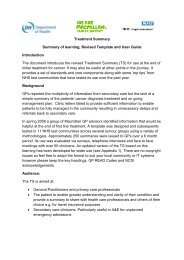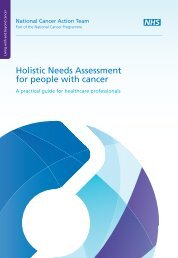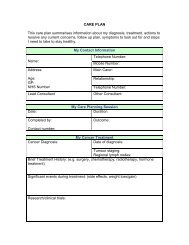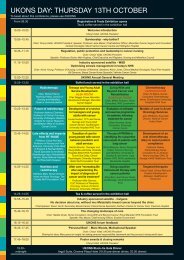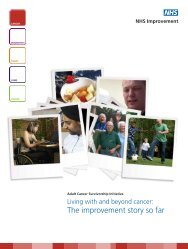HOPE Protocol [PDF, 420KB] - National Cancer Survivorship Initiative
HOPE Protocol [PDF, 420KB] - National Cancer Survivorship Initiative
HOPE Protocol [PDF, 420KB] - National Cancer Survivorship Initiative
You also want an ePaper? Increase the reach of your titles
YUMPU automatically turns print PDFs into web optimized ePapers that Google loves.
Footnotes<br />
1 A rapid review aimed at updating that of ‘Evidence to inform the <strong>Cancer</strong> Reform Strategy:<br />
The clinical effectiveness and cost-effectiveness of follow-up services after treatment for<br />
cancer, ‘as conducted by the Centre for Reviews and Dissemination (2007) is currently<br />
underway.<br />
2 Davies, NJ (2009a,b) Self-Management Programmes for <strong>Cancer</strong> Survivors: A Structured<br />
Review of Outcome Measures, commissioned by Macmillan <strong>Cancer</strong> Support for the NCSI.<br />
3 A report by the Picker Institute, commissioned by NHS Improvement and Macmillan <strong>Cancer</strong><br />
Support, demonstrated an implicit assumption among survivors and carers that ‘follow-up’<br />
care occurs when treatment has ended (Sheldon, Davis, and Parsons, 2008). Therefore, the<br />
baseline measurement period of 6-weeks post-treatment encompasses this shared definition<br />
whilst also providing time between final treatment and the intervention for survivors to<br />
become socially reintegrated.<br />
4 Health status evaluations have been demonstrated to change according to age and illness<br />
(Kaplan and Orna Baron-Epel, 2002); Demographic variables such as age and educational<br />
status might be important predictors of quality of life and thus need to be controlled when<br />
analysing data (Wenzel et al, 1999).<br />
5 Evidence exists in the way of social support being a potential buffer against disease<br />
progression (Smith et al., 1994), as well as being positively associated with better<br />
psychological well-being (Stanton and Snider, 1993; Rodrigue, Behen, and Tumlin, 1994)<br />
and better psychosocial adjustment (Heim et al., 1997).<br />
6 It is important to control for socio-economic status (SES) as it is related to health<br />
behaviours, such as breast screening (Yarbrough and Braden, 2001). However, the most<br />
effective method of measuring SES has been under debate, with potential indicators being<br />
income, occupation, postcode, educational status, to name a few (Deonandan et al., 2000;<br />
Shavers, 2007). Educational attainment is perhaps the most widely used indicator of SES<br />
due to the ability to characterise the educational achievement level of most individuals.<br />
Furthermore, education can be seen as the most basic component of SES because of its<br />
influence on other SES indicators such as occupation and income (Adler and Newman,<br />
2002). There are several possible mechanisms through which education might influence<br />
health status. For example, people with higher education may have developed better<br />
information-processing and critical thinking skills, skills in navigating health services, and<br />
abilities required to interact effectively with healthcare providers. Individuals with higher<br />
education may also be more likely to be socialised to health-promoting behaviour and<br />
lifestyles, and have better work, economic conditions, and psychological resources (Ross<br />
and Mirowsky, 1995; Yen and Moss, 1999). An advantage of using education as a measure<br />
of SES for adults is that the likelihood of reverse causation (e.g., which came first, poor<br />
health or low SES)—which can be a problem with other standard SES measures—is<br />
reduced, as education is usually complete before detrimental health effects occur (Stewart,<br />
2001).<br />
7 Co-morbidities have been found to correlate with various dimensions of quality of life in<br />
women with breast cancer (Davies et al., 2008).<br />
20/08/09<br />
15


![HOPE Protocol [PDF, 420KB] - National Cancer Survivorship Initiative](https://img.yumpu.com/32566432/15/500x640/hope-protocol-pdf-420kb-national-cancer-survivorship-initiative.jpg)
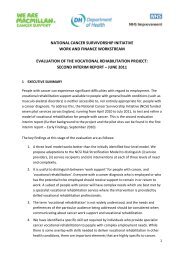
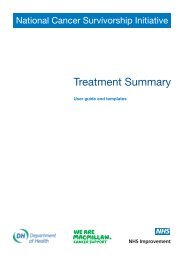

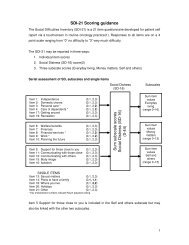
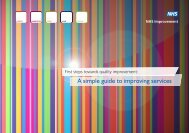
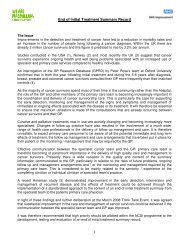
![Download the how to guide [PDF] - Macmillan Cancer Support](https://img.yumpu.com/47067428/1/184x260/download-the-how-to-guide-pdf-macmillan-cancer-support.jpg?quality=85)
